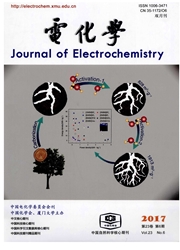

 中文摘要:
中文摘要:
应用电化学阻抗谱(EIS)研究碳钢在N-甲基二乙醇胺(MDEA)介质中的腐蚀行为.实验表明,未经预阴极活化处理的碳钢表面存在氧化膜,溶解氧促使它腐蚀速率增大,经活化处理去除氧化膜后则相反.在不含热稳定性盐(HSS)的MDEA溶液中,碳钢的腐蚀性随MDEA浓度的增加呈先上升后下降趋势;而在HSS高含量的溶液中,其腐蚀性则随MDEA浓度的增加而单调下降.在含有HSS模拟溶液中,碳钢的阳极极化EIS随极化电位由低到高分别出现感抗、负阻抗以及Warburg阻抗响应等特征,对应于孔蚀、活化状态向钝化状态过渡以及进入钝化的趋势,腐蚀反应的阴极过程表现为电化学反应和扩散传质混合控制,阳极过程为电化学反应控制.
 英文摘要:
英文摘要:
Corrosion behavior of carbon steel in methyldiethanolamine (MDEA) solution was investigated by Electrochemical Impedance Spectroscopy (EIS). The results were showed that the corrosion rate of carbon steel in solution containing dissolved oxygen is higher than that in solution removed of dissolved oxygen before cathodic activation. They were reversed after cathodic activation. The corrosion rate is increased at first and then decreased when the concentration of MDEA is increased in the blank solutions. In the simulated solutions containing quantities of heat-stable salts ( HSS), the corrosion rate is decreased monotonously with increase of the MDEA concentration. As anodic polarization potential is increased, the EIS of carbon steel in HSS simulated solution showed characteristics of inductive shrinkage, negative impedance and Warburg-respense, which implied pitting corrosion, transition from active state to passive state and passive state, respectively. The rate of cathodic reduction is determined by both electrochemical reaction and diffusion process. The rate-determining step of the anodic dissolution is electrochemical reaction.
 同期刊论文项目
同期刊论文项目
 同项目期刊论文
同项目期刊论文
 Reduction of the Impedance of a Contactless Conductivity Detector for Microchip Capillary Electropho
Reduction of the Impedance of a Contactless Conductivity Detector for Microchip Capillary Electropho Comparison of liquid chromatographic behaviors on N-methylimidazolium functionalized ZrO2/SiO2-4 and
Comparison of liquid chromatographic behaviors on N-methylimidazolium functionalized ZrO2/SiO2-4 and Preparation of dye–ligand affinity chromatographic packings based on monodisperse poly(glycidylmetha
Preparation of dye–ligand affinity chromatographic packings based on monodisperse poly(glycidylmetha Cation effects in the separation of calix[4]pyrroles by nonaqueous capillary electrophoresis with te
Cation effects in the separation of calix[4]pyrroles by nonaqueous capillary electrophoresis with te Comparison of Anion-Exchange and Hydrophobic Interactions between Two New Silica-Based Long-Chain Al
Comparison of Anion-Exchange and Hydrophobic Interactions between Two New Silica-Based Long-Chain Al Different experimental results for the influence of immersion angle on the resonant frequency of a q
Different experimental results for the influence of immersion angle on the resonant frequency of a q Determination of betaine, choline and trimethylamine in feed additive by ion-exchange liquid chromat
Determination of betaine, choline and trimethylamine in feed additive by ion-exchange liquid chromat Simultaneous determination of fluoride, chloride, sulfate, phosphate, monofluorophosphate, glyceroph
Simultaneous determination of fluoride, chloride, sulfate, phosphate, monofluorophosphate, glyceroph Arsenic species analysis by ion chromatography–bianode electrochemical hydride generator–atomic fluo
Arsenic species analysis by ion chromatography–bianode electrochemical hydride generator–atomic fluo Analysis of indandione anticoagulant rodenticides in animal liver by eluent generator reagent free i
Analysis of indandione anticoagulant rodenticides in animal liver by eluent generator reagent free i Preparation and evaluation of a silica-based 1-alkyl-3-(propyl-3-sulfonate)
imidazolium zwitterionic
Preparation and evaluation of a silica-based 1-alkyl-3-(propyl-3-sulfonate)
imidazolium zwitterionic Determination of steroid sex hormones in wastewater by stir bar sorptive extraction based on poly(vi
Determination of steroid sex hormones in wastewater by stir bar sorptive extraction based on poly(vi Hydrogen-bond effect and ion-pair association in the separation of neutral calix[4]pyrroles by nonaq
Hydrogen-bond effect and ion-pair association in the separation of neutral calix[4]pyrroles by nonaq Determination of impurities in flame retardant monomer 2-carboxylethyl(phenyl) phosphinic acid by io
Determination of impurities in flame retardant monomer 2-carboxylethyl(phenyl) phosphinic acid by io Determination of five 4-hydroxycoumarin rodenticides in animal liver tissues by ion chromatography w
Determination of five 4-hydroxycoumarin rodenticides in animal liver tissues by ion chromatography w 期刊信息
期刊信息
